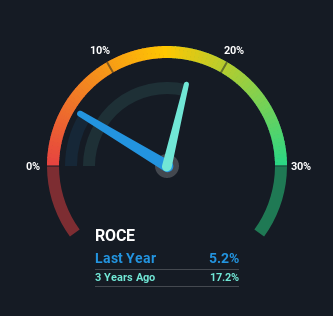- Israel
- /
- Oil and Gas
- /
- TASE:ORL
Oil Refineries' (TLV:ORL) Returns On Capital Tell Us There Is Reason To Feel Uneasy
To avoid investing in a business that's in decline, there's a few financial metrics that can provide early indications of aging. Businesses in decline often have two underlying trends, firstly, a declining return on capital employed (ROCE) and a declining base of capital employed. This combination can tell you that not only is the company investing less, it's earning less on what it does invest. Having said that, after a brief look, Oil Refineries (TLV:ORL) we aren't filled with optimism, but let's investigate further.
What is Return On Capital Employed (ROCE)?
For those that aren't sure what ROCE is, it measures the amount of pre-tax profits a company can generate from the capital employed in its business. Analysts use this formula to calculate it for Oil Refineries:
Return on Capital Employed = Earnings Before Interest and Tax (EBIT) ÷ (Total Assets - Current Liabilities)
0.052 = US$140m ÷ (US$4.2b - US$1.5b) (Based on the trailing twelve months to June 2021).
So, Oil Refineries has an ROCE of 5.2%. Ultimately, that's a low return and it under-performs the Oil and Gas industry average of 13%.
View our latest analysis for Oil Refineries

While the past is not representative of the future, it can be helpful to know how a company has performed historically, which is why we have this chart above. If you want to delve into the historical earnings, revenue and cash flow of Oil Refineries, check out these free graphs here.
How Are Returns Trending?
We are a bit worried about the trend of returns on capital at Oil Refineries. To be more specific, the ROCE was 12% five years ago, but since then it has dropped noticeably. On top of that, it's worth noting that the amount of capital employed within the business has remained relatively steady. Companies that exhibit these attributes tend to not be shrinking, but they can be mature and facing pressure on their margins from competition. If these trends continue, we wouldn't expect Oil Refineries to turn into a multi-bagger.
The Bottom Line
In summary, it's unfortunate that Oil Refineries is generating lower returns from the same amount of capital. Investors haven't taken kindly to these developments, since the stock has declined 25% from where it was five years ago. Unless there is a shift to a more positive trajectory in these metrics, we would look elsewhere.
Oil Refineries does come with some risks though, we found 4 warning signs in our investment analysis, and 2 of those are significant...
If you want to search for solid companies with great earnings, check out this free list of companies with good balance sheets and impressive returns on equity.
New: AI Stock Screener & Alerts
Our new AI Stock Screener scans the market every day to uncover opportunities.
• Dividend Powerhouses (3%+ Yield)
• Undervalued Small Caps with Insider Buying
• High growth Tech and AI Companies
Or build your own from over 50 metrics.
This article by Simply Wall St is general in nature. We provide commentary based on historical data and analyst forecasts only using an unbiased methodology and our articles are not intended to be financial advice. It does not constitute a recommendation to buy or sell any stock, and does not take account of your objectives, or your financial situation. We aim to bring you long-term focused analysis driven by fundamental data. Note that our analysis may not factor in the latest price-sensitive company announcements or qualitative material. Simply Wall St has no position in any stocks mentioned.
Have feedback on this article? Concerned about the content? Get in touch with us directly. Alternatively, email editorial-team (at) simplywallst.com.
About TASE:ORL
Oil Refineries
Produces and sells fuel products, intermediate materials, and aromatic products in Israel and internationally.
Adequate balance sheet and fair value.
Similar Companies
Market Insights
Community Narratives



